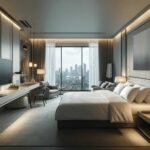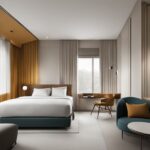In the hospitality industry, interior design plays a critical role in shaping guest experiences. The way a hotel or restaurant is designed directly affects comfort, ambiance, functionality, and overall satisfaction. However, many establishments make common hospitality design mistakes that can lead to negative reviews, customer discomfort, and decreased bookings.
These hotel interior design errors often stem from poor lighting choices, improper furniture layout, lack of accessibility, and uninspired décor. As a result, guests may feel uncomfortable or unimpressed, leading them to seek accommodations elsewhere. Fortunately, by understanding these design flaws, hospitality businesses can make informed decisions to improve their spaces.
Table of Contents
Toggle- Poor Lighting: The Most Overlooked Hospitality Design Mistake
- Uncomfortable and Poorly Arranged Furniture
- Ignoring the Importance of Acoustics
- Lack of Accessibility for All Guests
- Overuse of Trends Instead of Timeless Design
- Insufficient Storage and Cluttered Spaces
- Outdoor Spaces That Are Underutilized
- The Takeaway: Fixing Hospitality Design Mistakes to Improve Guest Experience
- The Advantages of Custom Luxury Hotel Furniture
- The Importance of Custom Hotel Furniture in Enhancing Guest Experience
- The Ultimate Guide to Finding Top Hotel Furniture Suppliers in Turkey
- Importance of High Quality Furniture in Hotels
- The Impact of Furniture Design on Hotel Guest Experience
- High Quality Furniture in Hotels: Essential for Guests
- The Role of Furniture in Defining Hotel Aesthetics
- The Evolution of Hotel Furniture Design Over the Years
- How to Choose the Right Upholstery for Hotel Furniture
- The Impact of Furniture Design on Guest Experience in Hotels
- Hotel Furniture and Design: Enhancing the Guest Experience
- Premium Hotel Furniture in Turkey: Elevate Your Hotel’s Interior Design
- How Do Hotels Get Furniture in the Rooms | Hotel Solutions
- Hotel Furniture Concept | Perfect Products for Your Hotel
- Top 5 Benefits of Turkish Made Hotel Furniture
- What makes a good faux leather?
- Furnishing an Apartment: 6 Tips for Choosing the Best Furniture
- Types Of Hotel Furniture You Need
- Why Turkish Made Hotel Furniture is the Best Choice for Your Business
- What is fixed furniture?
- Maximizing Your Hotels ROI with High-Quality Furniture Solutions
- Benefits of Custom Made Furniture
- Hotel Furniture Buying Guide
- Where Do I Buy Hotel Furniture in Turkey?
- How to Make a Hotel Room Feel Like Home
- How Often Do Hotels Change Their Interiors?
- A Good Hotel Furniture Manufacturer
- 7 Signs Your that Hotel Needs Renovation
- What Factors Will Affect Hotel Furniture Prices?
- Should I Buy Laminate or Veneer Furniture?
- MDF Cutting Machine
- What are the Basic Furniture Required to Set Up a Hotel?
- What is Crib 5?
- Four Ways to Maintain Hotel Room Storage
- Characteristics of a Custom Hotel Furniture
- Popular Materials for Luxury Hotel Furniture Manufacture
- The Four Characteristics of a Hotel Furniture Design
- 4 Key Considerations for Hotel Furniture
- Hotel Furniture Quality Control Checklist
- Things Your Hotel Furniture Manufacturer Should Provide
- Why we use 3D Renderings in Furniture Design
- Advantages of Custom Hotel Furnitures
- Important Questions to Ask a Potential Hotel Furniture Supplier
- What Are the Guides to Contract Furniture?
- Things to Consider When Choosing a Hotel Furniture Manufacturer
- Wood Veneers and Laminate Casegoods
- Wooden Furniture Care
- What Types Of Wood Are The Best For Your Luxury Sofa?
- Hotel Furniture Cushion Upholstery Care
- Leather Furniture Care; Maintaining Your Hotel Furniture
- Ten Tips for Hotel Lobby Design
- Starland Hotel Cameroon
- Hotel Furniture Turkey
- The Best Hotel Furniture Suppliers
- Hotel Furniture Manufacturers in Turkey
- Four Mistakes While Buying a Restaurant Furniture in Turkey 2021
- Selecting Booth and Sofa Seating Made in Turkey
- 10 Restaurant And Cafe Furniture Ideas From Turkey
- Five Most important Materials in Hotel Furniture Industry
- Hotel Renovations: Luxury Hospitality Furnishings made in Turkey
- How to Maintain Hotel Furniture for 10+ Years
- Commercial VS Residential Furniture Made in Turkey
- Hotel Furniture Manufacturing Industry in Turkey
Poor Lighting: The Most Overlooked Hospitality Design Mistake
Lighting is one of the most underestimated aspects of hospitality design, yet it has a significant impact on ambiance and mood. Many hotels either install fixtures that are too dim, creating a gloomy atmosphere, or overly bright lights, leading to an unpleasant experience.
How to Fix It:
Use adjustable lighting to create a balanced atmosphere for different times of the day.
Incorporate warm lighting in guest rooms and lounges for a cozy and inviting feel.
Install task lighting in workspaces to ensure functionality for business travelers.
Uncomfortable and Poorly Arranged Furniture
Many hotels invest in visually appealing furniture, but fail to prioritize comfort and functionality. If chairs, sofas, and beds lack ergonomic support, guests will have an unpleasant stay, which can lead to negative reviews. Additionally, poor furniture placement creates cluttered or inefficient layouts, making spaces feel cramped or unwelcoming.
How to Fix It:
Choose ergonomic hotel furniture that provides both comfort and support.
Arrange furniture in a way that maximizes space while maintaining aesthetic appeal.
Opt for custom hotel furniture that blends style with practicality.
Ignoring the Importance of Acoustics
Another common hospitality design mistake is overlooking soundproofing and acoustics. Guests expect a quiet and relaxing environment, yet many hotels fail to incorporate proper noise reduction measures.
How to Fix It:
Use acoustic panels or fabric wall coverings to minimize noise disturbances.
Invest in soundproof doors and windows to reduce external noise pollution.
Place rugs and upholstered furniture strategically to absorb sound.
Lack of Accessibility for All Guests
In today’s hospitality industry, inclusivity and accessibility are essential. Yet, many hotels and restaurants fail to accommodate guests with mobility challenges, making spaces difficult to navigate.
How to Fix It:
Ensure doorways and hallways are wide enough for wheelchair users.
Install ramps and elevators to provide easy access to all areas of the hotel.
Incorporate bathroom grab bars, adjustable beds, and tactile signage to improve guest accessibility.
Overuse of Trends Instead of Timeless Design
While staying on top of hospitality design trends is important, overusing trendy décor can make spaces feel outdated quickly. Many hotels make the mistake of prioritizing aesthetics over longevity, leading to frequent renovations and high costs.
How to Fix It:
Focus on timeless design principles with neutral color palettes and classic furniture styles.
Use trendy décor elements in accents (e.g., throw pillows, artwork) rather than permanent fixtures.
Invest in high-quality materials that maintain a sophisticated and enduring look.
Insufficient Storage and Cluttered Spaces
Guests appreciate clean, organized, and clutter-free hotel rooms. However, some hotels fail to incorporate sufficient storage options, leaving luggage, clothing, and personal belongings without a proper place.
How to Fix It:
Include built-in wardrobes and smart storage solutions in guest rooms.
Provide under-bed storage options for convenience in compact spaces.
Ensure that lobby and reception areas remain minimalist and well-organized.
Outdoor Spaces That Are Underutilized
A well-designed outdoor area adds immense value to a hotel, yet many properties overlook the potential of terraces, patios, and poolside areas. Poor landscaping, lack of seating, and uninviting outdoor designs make these spaces underwhelming and unused.
How to Fix It:
Incorporate comfortable outdoor seating and lounge areas to create welcoming spaces.
Add outdoor lighting to enhance ambiance and improve evening aesthetics.
Include greenery, fire pits, or water features to make the area visually appealing.
The Takeaway: Fixing Hospitality Design Mistakes to Improve Guest Experience
Avoiding these hospitality design mistakes is essential for enhancing guest satisfaction, optimizing space, and ensuring a visually pleasing atmosphere. By prioritizing functionality, comfort, and timeless design, hotels can create inviting spaces that leave a lasting impression on visitors.
Investing in well-planned hotel interiors enhances guest comfort and drives positive reviews, leading to increased bookings and customer loyalty.



